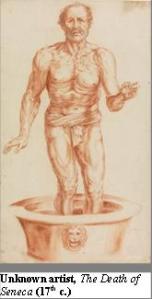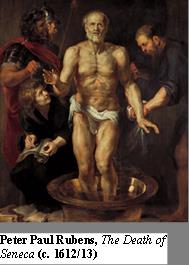RESPONSE #1 – Tullia Giersberg
LET’S TALK ABOUT CHALK: THE ARTWORK AS A NETWORK OF MATERIALLY CONDITIONED MEANINGS
All works of art tell a story. Some are more interesting than others. But what of the artefact? What kinds of histories does it tell? What were the conditions of its production? Where has it been? Who has owned it? Perhaps most importantly, how does its material composition reflect upon its aesthetic value?
Today’s post offers a few preliminary thoughts on the kinds of stories implicit in the material composition of The Death of Seneca, one of two seventeenth-century artworks depicting the Stoic philosopher’s suicide housed in the UCL Art Museum. Instead of thinking about the drawing-as-art, this is to be an experiment in thinking with the drawing-as-object.
A precursory glance at the history books tells us that Lucius Annaeus Seneca was born around 1 BC and died AD 65, condemned to commit suicide by the Emperor Nero over his alleged participation in the Pisonian conspiracy. Seneca duly opened his veins, stepped into a bathtub filled with warm water, and, demonstrating Stoic indifference to his own mortality, waited for the end. It is this moment of transcendence which The Death of Seneca foregrounds by way of memento mori, the shock of the dying man’s bulging veins and receding flesh softened by the warm glow of red chalk on cream-coloured paper. There are no gushing rivers of blood (unlike, for example, in Peter Paul Rubens’s 1613 oil painting of the same scene), and there is no suggestion of physical violence done to the subject’s body.
However, the chalk which lends the finely drawn figure of Seneca its delicately highlighted contours, as well as the etymological and metaphorical networks of meaning within which it is embedded, reveals a slightly different story.
According to Claire van Cleave’s Master Drawings of the Italian Renaissance (2007), naturally occurring red chalk, which became popular as a drawing implement in the fifteenth century, is composed of clay, iron oxide, and haematite, a mineral form of iron oxide. Its constituent components invite associations congruent with traditional interpretations of the drawing’s topos: clay suggests a return to earth and dust through death; the iron oxide conjures images of Stoic resolve then most commonly expressed in metaphors of metal and stone. In this respect, the unknown artist’s choice of materials complements his chosen topic.
The haematite, on the other hand, from the Latin ‘lapis hæmatites’, literally ‘blood-red stone’, compromises the sanitized version of martyrdom the drawing presents to the viewer, encoding a suggestion of violence into the molecular structure of the object which the artwork successfully manages to suppress, thereby complicating, perhaps even countermanding, its aestheticization of death. More importantly, red chalk drawing is often referred to as sanguine drawing for its potential to faithfully render flesh tones. The word ‘sanguine’ carries a variety of meanings, including ‘bloodthirsty’. But in Renaissance physiology a reddish or ‘ruddy’ complexion was thought to signal above all ‘cheerfulness’, or even ‘hopefulness’ (OED) – meanings which colour this Death of Seneca in deep shades of irony.
There is, then, a discrepancy between those meanings the drawing generates as a work of art, and those it generates as a materially conditioned object. This tension not only puts new demands on our material literacy, reminding us that matter matters; it also encourages us to interrogate the existing economy of aesthetic values which confers cultural currency upon objects and transforms them into art.


